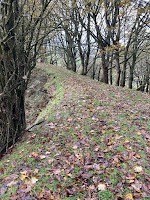The Castle at Painscastle
Last time my blog post was all about Cariad Chapter's wonderful first retreat in Painscastle, a small village just a few miles away from Hay-on-Wye. We'd all seen the photos on the website but nothing compared to actually seeing the Grade II listed building where we were going to be staying. Named The Castle, the beautiful house, set on a working farm, has been tastefully renovated yet very much in keeping with the time it was built. The creaky floorboards as well as the sloped ceilings and beams of the attic rooms were ideal for writers' imaginations to come alive. Who once lived there? What secrets did the families hold?It was even more fascinating when we ventured outside. After walking up through the garden, we travelled back hundreds of years when we came to the ramparts of the castle that gave the village its name. The castle site is on enclosed farmland with no public access so we felt privileged to be able to wander up from the house and see it for ourselves. All that remains now is a series of earthworks. The now grassy mounds show where a major stone castle once stood in a prominent position in a small village. Its location seems to be off the beaten track but it does, in fact, stand on one of the major routes from England into Rasdnorshire.
The castle was built in the twelfth century by Payn Fitz John, one of King Henry 1's men, and after whom it was named. It was rebuilt in stone a century later due to repeated attacks by the Welsh. Painscastle castle had a chequered history; one of its most remarkable events was when three thousand Welsh men were slaughtered in a pitched battle between the English and the Welsh. It became the bloodiest massacre in Welsh history It was said that the River Bachaway ran red with blood.
On the east side of the castle is a derelict house that played a part in Painscastle's history. A white-washed manor house of lordship status, Upper House sits adjacent to the castle bank and is thought to date from the mid-fifteenth century. It would suggest that there was now a shift of power from the fortified castle to a nobleman's home which was undefended. The fact that the hall juts into the outside ditch suggests that by then the castle had lost its military role. Walking around the castle ruins with the panoramic views of the beautiful Radnorshire landscape all around made me think of all that had gone before and was part of the history of that small village we were staying in for a short time.
Thank you for reading. I hope you've enjoyed hearing a little more about the place where the Cariad Chapter spent its writing retreat. How do places with a lot of history affect you? Have you been inspired to write by a location with a lot of history? If you have, I'd love it if you left a comment saying where it was. Thanks.
STOP PRESS
Yesterday I attended the launch of Worcestershire Lit Fest and Fringe Flash Fiction Anthology 2023 in which I was delighted to have three flashes included again this year. For the first time, it was good to see several members of the Blackwood Library Writing Group reading out their excellent flashes there as well. The group is run by my friend and librarian, Helen Beckett. Here I am reading out my shortlisted Flash Body Beautiful.
Copies are available from Black Pear Press.
You may also follow me on:
X/ Twitter: @JanBaynham
Facebook: Jan Baynham Writer
Instagram: janbaynham
For more about me and all my books, please visit my AMAZON page.








No comments:
Post a Comment